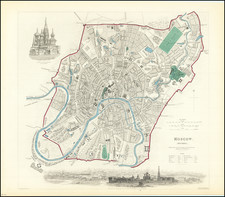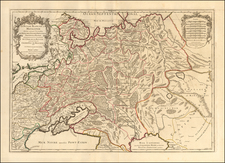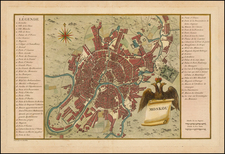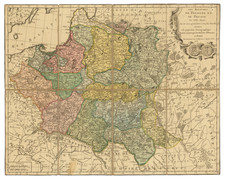Scarce sea chart of the Caspian Sea and environs, with a large decorative vignette of Astrakan from the water and smaller vignettes of Samagael and Derbent.
Marvelous detailed sea chart, with rhumblines, soundings, compass rose and other details, oriented with east at the top of the map.
One of the best commercial sea charts of the region published in the 18th Century. Includes rhumblines, topographical details, soundings, and a host of other details. As noted in the Maphist history page:
The van Keulen family operated a chart-making and publishing firm in Amsterdam for nearly 200 years. It was founded by Johannes van Keulen who registered his business as a "bookseller and cross-staff maker." Under his management the Nieuwe Lichtende Zee-Faakel (New Shining Sea Torch) was begun in 1681. It was expanded to five volumes, and finally to six volumes with the addition of material from the secret files of the East India Company. In 1693 van Keulen acquired the stock of Hendrik Doncker.
In 1678, Johannes registered with the Amsterdam Booksellers Guild as a "bookseller and Cross-staff maker" By this time, most of the Amsterdam chart makers and instrument makers, like Blaeu, Janssonius, Hondius, Goos, and Doncker, had either closed down or were at the end of their fame. As a result, Johannes van Keulen had the opportunity to obtain copperplates, privileges, and stocks of many of his former competitors. Besides manuals and cross-staffs, Johannes produced his famed "ZeeAtlas"(Sea Atlas, 5 volumes), and "ZeeFakkel" (Sea pilotbook, 5 volumes). ZeeFakkel was produced in numerous languages, including English, French, Italian, and Spanish.
Gerard van Keulen, son of Johannes, born 1678, took over from his father in 1714 and continued to expand the flourishing firm. Gerard's accomplishments include hundreds of manuscript charts, which are now kept in a number of European collections. In 1726, Johannes van Keulen, son of Gerard, took over the business. In 1743, Johannes was appointed "Official Chartmaker of the Dutch East Indies Company". The title appears to be nothing more than a formality, however, since the firm had been supplying charts to the East Indies Company for many years prior, and considering that the van Keulen family of Amsterdam had an interest in the East Indies Company. Still, van Keulen Chartmakers held the official title, until the East Indies Company was dissolved in 1799.
In 1753, Johannes finished his grandfather'' work, by publishing the sixth volume of "ZeeFakkel". This volume contained the previously kept secret cartography of The East India Archipalago. Jan de Marre, examiner of the Amsterdam Chamber of the East Indies Company, provided van Keulen with the data for the ZeeFakkel sixth volume, and it is also believed that de Marre was involved in the van Keulen chartmakers decision to start production of the newly invented Hadley's Octants in 1744.
Following the death of Johannes van Keulen(1770), the company was run by his widow and their two sons, Cornellis Buys and Gerard Hulst van Keulen. By this time, they also owned an anchor factory, which was managed separately.
In 1778, with the death of brother Cornellis, Gerard Hulst van Keulen would assume the head of the chartmaker firm, adding sextants to their inventory for sale. Gerard was one of the three original members of the "Dutch Commission for Longitude at Sea", installed by the Dutch Admiralty in 1787. In 1788, Gerard van Keulen published the first "Dutch Nautical Almanac", and annual publication of same continued until 1885.
When Gerard Hulst van Keulen died in 1801, his widow ran the firm until her death in 1810, at which time Johannes Hulst van Keulen became the last van Keulen to run the firm. In 1823, Jacob Swart entered the service of the van Keulen firm, and in 1844, with the death of Johannes Hulst van Keulen, head of the van Keulen Chartmakers was passed to Jacob Swart. When Jacob died in 1866, he was succeeded by his son, Jacob Swart, Jr. Under Jacob, Jr's reign, the firm lost all of its standing in the Nautical world, and the possessions of the firm were sold at auction in 1885, bringing 200 years of "DeGekroonde Lootsman" to an end.
The Van Keulens were a family of chartmakers and publishers. The firm, In de Gekroonde Lootsman (In the Crowned Pilot), was founded in 1678 by Johannes van Keulen (1654-1715). Van Keulen originally registered his business as a vendor of books and instruments (specifically cross-staffs). In 1680, however, he gained a privilege from the States of Holland and West Friesland for the publication of pilot guides and sea atlases.
In that year, van Keulen released his Zee-Atlas (Sea Atlas), which secured him a name in the competitive maritime publishing market. In 1681, he published the first volume of Nieuwe Lichtende Zee-Fakkel (New Shining Sea Torch). This would be the first of an eventual five volumes originally published between 1680 and 1684. A sixth volume was added in 1753. The Zee-Fakel won van Keulen lasting fame. The atlas had charts compiled by Claes Jansz Vooght and artwork from Jan Luyken. It proved immensely popular and was reprinted until 1783. There were translations in French, English, Spanish, and Italian.
The late-seventeenth century was an auspicious time to enter the maritime chart business. Previous industry leaders had either closed shop, died, or retired, leaving space for a new competitor. Van Keulen proceeded to buy up the stock and privileges of several maritime publishing firms; the most notable was the stock of Hendrik Doncker, acquired in 1693.
Johannes’ son, Gerard (1678-1726) took over the business upon his father’s death. Gerard was a skilled engraver and mathematician. His talents were noticed, as in 1706 he was named as Hydrographer to the Dutch East India Company (VOC).
In turn, Gerard’s son Johannes II (1704-1770) came to run the shop. He was also tied to the VOC, and his role as their chartmaker allowed his charts to be considered as quasi-official government documents. It is with access to formerly clandestine VOC geographic knowledge that Johannes the Younger was able to add a sixth volume to the Zee-Fakkel, which covered the East Indies. Johannes also continued to sell instruments, including the recently-invented Hadley’s Quadrant from 1744.
When Johannes II died in 1770, his widow ran the business in his stead, aided by her two sons, Cornelis Buys (1736-1778) and Gerard Hulst (1733-1801). Now a century old, the family business had extended to include an anchor factory. After Cornelis died in 1778, Gerard took on the management of the firm alone. He oversaw the introduction of sextants to their inventory and published the Dutch Nautical Almanac beginning in 1788. Annual editions appeared until 1885. Gerard also served as an original member of the Dutch Commission for Longitude at Sea from 1787.
Gerard’s widow ran the business for nine years after his death, when their son, Johannes Hulst, started to lead the firm in 1810. After his death in 1844, the firm passed out of family hands and into the control of Jacob Swert, a skilled cartographer who had worked for the business for two decades. He passed the work to his son, another Jacob, in 1866. By the mid-nineteenth century, the conversion from sail to steam had diminished the size of the market for charts. Fewer sailors needed fewer maps, charts, and instruments. In 1885, after 207 years in business, In de Gekroonde Lootsman closed its doors and auctioned its stock.









![[Uniforms and Insignia of the German Army] Форма Обмундирования и Знаки Различия Германской Армии](https://storage.googleapis.com/raremaps/img/small/67803.jpg)

![Russiae et Novae Zemlae Maritimae [Maritime Russia and Novaya Zemlya.]](https://storage.googleapis.com/raremaps/img/small/92722.jpg)


